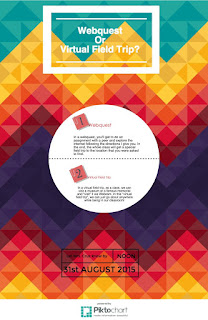Digital Post I
In chapter 6, I read the section called 'Webquest and Virtual Field Trips'. In this small section, they mention how to get students into learning in a different approach. One way to do that would be creating a Webquest. A webquest is an online "lesson" where your teacher creates a lesson and you have to complete it via internet. Since we did one for this class, it was much easier to understand the process behind it. In the end, I can see how it can helps students who don't like the paper form of work and turn it into a project that's much more interactive. Webquests are meant to be meaningful and also useful the same way it would be in a classroom if you did it by the book and with worksheets. Personally, a webquest would be more effiecent in a higher level classroom.
Credit to DariszSankowski at Pixabay
The following section "videoconferencing" is similar to a "virtual field trip". Videoconferencing is when a group of students, or even a classroom, video chat with another classroom in a different location. By doing this, it can help students get involved with different students in the same age group. It can also help the teachers interact and give feedback on what they're doing in the classroom. For example, my school has a dual language program and K-1 have half a day in English and the other half in Spanish. Last week we had a video conference with another classroom in Palm Beach and the experience is amazing. It's an eye opener and also very nice to have that interaction with teachers and students who are also doing the same content we are.

The last section 'Educational Websites as Teaching Resources' mentions lots of helpful websites. For example, they list "lesson plan" websites to help a teacher makes lesson plans and they also mention "skills/practice" websites. In my classroom, we use "skills/practice" websites to help with centers. An example of a "skills/practice" website would be www.abcya.com. While the teacher and I meet in small groups, students alternate in centers and going on this website on the computer is one of them. But there is many websites besides the one I mentioned that could be used in a classroom. There is many other websites that can also help with exploration and discovery and with science/math work as well.
Resources:
- Maloy, Robert, Verock-O’Loughlin,Ruth-Ellen, Edwards, Sharon A., and Woolf, Beverly Park (2013). Transforming Learning with New Technologies. 2nd Edition. Boston, MA: Pearson Education, Inc.
- Cruz, Danielle. November 4, 2015. Untitled Banner. Piktochart.com


Embedding the Picktochart - versus uploading as an image - would help with not only being able to see the detail, but also make it more interactive! However you deserve kudos for trying it and also the other relevant Pixabay photo - nice job! WebQuests require a higher level of thinking and complexity and I do think they are properly best suited for upper elementary age students rather than the younger ones. Still one might do one together as a class for the inquiry and technology alone! :)
ReplyDelete